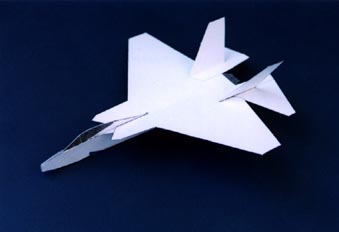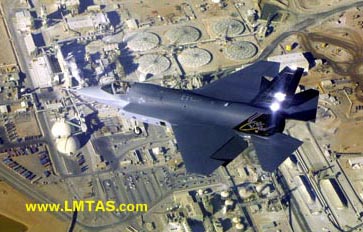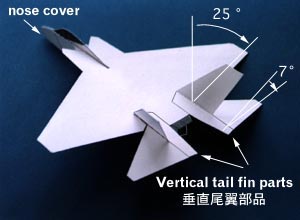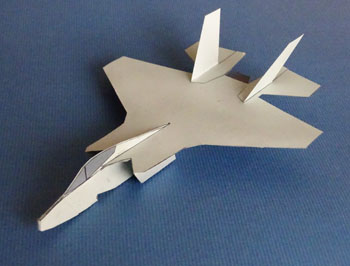



X-35(F-35) is one of the Concept Demonstration Aircraft of JSF(Joint Strike Fighter) developed by Lockheed Martin Aeronautics Company. The Joint Strike Fighter (JSF) Program is the Department of Defense's focal point for defining affordable next generation strike aircraft weapon systems for the Navy, Air Force, Marines, and US allies. The focus of the program is affordability -- reducing the development cost, production cost, and cost of ownership of the JSF family of aircraft. X-35A (conventional takeoff and landing (CTOL) version ) took off at Oct. 24 2000 on it's first flight. The X-35C (carrier variant (CV)) is designed to achieve superior carrier-suitable handling qualities within a highly common family of JSF airplanes. X-35C took the first flight at Dec. 16 2000. This paper aircraft is designed on the figure at Lockheed Martin A. C. web site, but it has some difference from X-35C of tested now in detail. Real X-35 has powerful engine and computer controlled stability. So it is not the best shape for paper glider performance, but this paper plane is flying well and stably when carefully adjusted. I think this paper aircraft is the first flying papermodel of X-35 in the world (at least on the web). Enjoy flight of near future aircraft.
Congratulations! Lockheed Martin X-35 is selected for
System Development and Demonstration (SDD) phase at Oct. 26
2001.
Update Rev 1.2 X-35
is
now
enumerated as the F-35. The Navy's F-35C version of the
plane is a carrier-based strike fighter. (For your reference, at
the test of X-35, X-35C is the carrier version.)
How to manufacture F-35C

Download the drawing and print it on thick paper. (Refer to Material and Instrument.) Set
up your printer for thick paper. Basic structure of paper airplane
is similar to F/A-18.
Cut the paper according to the thick line. Start with body of
plane. Fold up as dash and dot line " _ . _ . _" , and fold
down as dash line " - - - - " . Cockpit is surrounded partly in
the body. After folding, open and cover back side of plane in
paste or glue and re-fold.
Dihedral angle of main wings is 0 degree or slight. Bend down
(anhedral angle) horizontal tail wing at thin line by 7 degree.
This anhedral angle is not seen in real F-35, but it is effective
to avoid interference of main wings and increase stability for
paper airplane flight. Paste vertical tail fin parts on the inner
edge of horizontal tail wing (refer photo). Vertical tail fin is
inclined out by 25 degree from vertical line. Paste wing on the
body. Paste nose cover at nose of body. Cut out the catapulting
hook. No balance weight is needed.
Adjustment
Bend front edge of main wings slightly as a bow shape to make
camber. Form washout (decrease angle of incidence at wing
tip) at the tip of main wings to avoid tip stall and increase
stability. Bend up very slightly horizontal tail wing at front of
vertical tail fin as body line for pitch adjustment. Bend up
slightly rear of the outer part of horizontal tail wing. Spray
paint thinly if fly outdoor.
New! The F-35A is the air force
version (land version) of the F-35, the basic form of the F-35 and
the largest number (more than 2000 total) to be produced. In
Japan, as a successor to the F-4, more than 100 aircraft will be
introduced and used as the next-generation main fighter. Unlike
previous models, it is characterized by stealth (difficult to
appear on radar). The F-35A is exclusively for ground gliding, and
compared to the F-35C, it has superior maneuverability and
resistance to G (gravitational load). It is also expected to be
mass-produced, and because of its simple structure, it is expected
to be cheaper than other models.

Download F-35A
Drawing(pdf version)
Basically the same as the F-35C. I added an air intake. How to
make the air intake is the same as F-22 and F-15. It will increase
air resistance, but it will be more realistic and will also have
the effect of reinforcing the leading edge of the wing. There
seems to be no problem with the stability of the horizontal tail
even if the lower half angle is not attached. We recommend using
silver gray card stock.